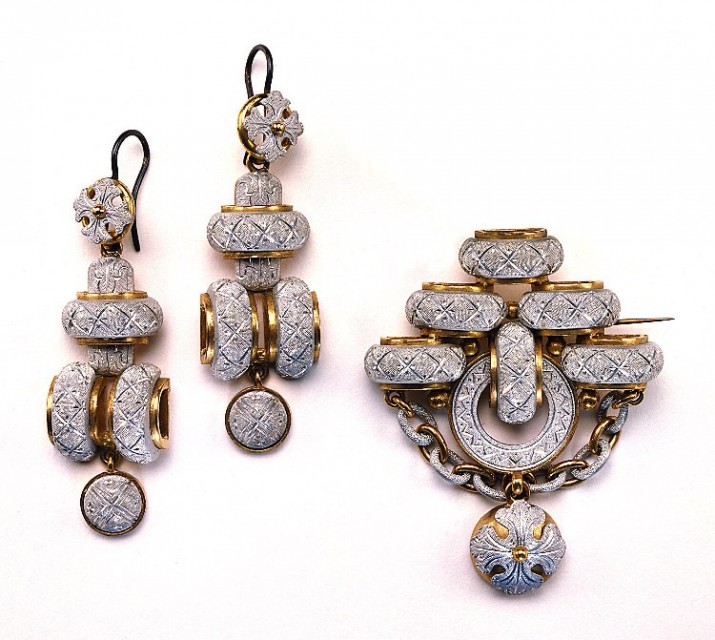The holiday season brings out the idea at least of festive parties, and, to some, that means putting on fancy clothes and jewelry. The idea of glittering adornment to dazzle goes back to antiquity and gold has been a constant. However, innovative use of new materials, so popular now, is not new. The choice of materials is ever evolving.
Aluminum, first produced in 1827 by a German chemist named Wöhler, did not leave the lab and become available through industrial processes until the early 1850’s. When it did, it was rare and expensive; so it seemed an appropriate choice for jewelry. It had the advantage over silver that it did not tarnish, and was very light, making it easy to wear. It also was extremely malleable which lent itself to the fancy scrolls and flourishes of the organic, scrolling rococo style that was being revived and expanded during the 1850’s. Exhibited at the Great Exhibition “Crystal Palace” in London in 1851, Queen Victoria had aluminum jewelry, which also received a fashionable endorsement through Empress Eugenie, wife of Napoleon III in France, who was among the first to wear such pieces. Some of the most important French jewelers took it up, thereby making the quality of the workmanship fine in the early examples of this new metal. Its cost seems to have made it the province of the specialist jewelers, such as Charles Henry Villamon, one of the possible authors of this suite, for the first few years. But, as the metal rapidly dropped in value with commercial production, it soon moved away from being used for jewelry for the few to almost costume-like status. By the end of the nineteenth century, it was no longer featured as a material for jewelry but moving closer to its modern associations with industrial usage.
More recent jewelers and designers who cut across classifications, such as David Tisdale’s bracelet (2013-29-1), have worked aluminum into more contemporary jewelry and even flatware. This jewelry is not about the preciousness of the materials, but about the design of the object, and the role that aluminum, by being light and not tarnishing, can play interacting in a large piece that otherwise might be too heavy to wear comfortably. With more traditional styling, it would just seem false. In the hands of a true jeweler and designer, the medium is understood and used for its properties.
These pieces are large, and would be very heavy to wear-look how long the earrings are-2 ½ inches. Think about the weight in the ears, or the brooch pulling on silk-were they to be made of gold, solid silver or bronze. What is also interesting is that these pieces were given during the Hewitt sisters’ era, at a time when aluminum had long since been made inexpensive and no longer used for jewelry. They were already rare antiques in 1928.
Festive Foil?
